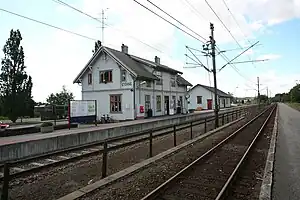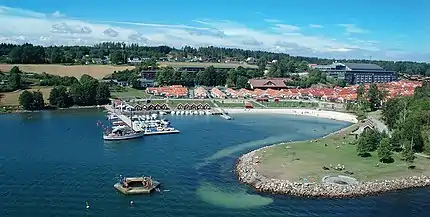Stokke Municipality
Stokke kommune | |
|---|---|
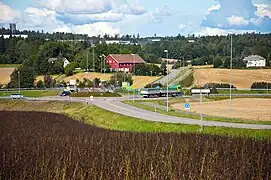 | |
 Flag | |
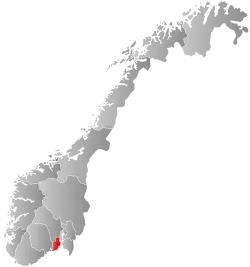 Vestfold within Norway | |
 Stokke within Vestfold | |
| Coordinates: 59°14′24″N 10°16′15″E / 59.24000°N 10.27083°E | |
| Country | Norway |
| County | Vestfold |
| District | Vestfold |
| Established | 1 Jan 1838 |
| • Created as | Formannskapsdistrikt |
| Disestablished | 1 Jan 2017 |
| • Succeeded by | Sandefjord Municipality |
| Administrative centre | Stokke |
| Area (upon dissolution) | |
| • Total | 118.36 km2 (45.70 sq mi) |
| • Land | 115.59 km2 (44.63 sq mi) |
| • Water | 2.77 km2 (1.07 sq mi) 2.3% |
| Population (2016) | |
| • Total | 11,657 |
| • Density | 98/km2 (260/sq mi) |
| Demonym | Stokkesokning[1] |
| Official language | |
| • Norwegian form | Bokmål[3] |
| Time zone | UTC+01:00 (CET) |
| • Summer (DST) | UTC+02:00 (CEST) |
| ISO 3166 code | NO-0720[4] |
Stokke is a former municipality in Vestfold county, Norway. The 118-square-kilometre (46 sq mi) municipality existed from 1838 until its dissolution on 1 January 2017. The area is now part of Sandefjord Municipality. The administrative centre was the village of Stokke. Other main villages in Stokke included Vear, Melsomvik, Storevar, and Valberg.
Upon its dissolution, the 118-square-kilometre (46 sq mi) municipality had a population of 11,657. The municipality's population density is 98 inhabitants per square kilometre (250/sq mi).[5][6]
General information
The parish of Stokke was established as a municipality on 1 January 1838 (see formannskapsdistrikt law). On 1 January 1901, the island of Håøya (population: 70) was transferred from Stokke to the neighboring Nøtterøy municipality. During the 1960s, there were many municipal mergers across Norway due to the work of the Schei Committee. On 1 January 1964, the island of Veierland (population: 165) was transferred from Stokke to the neighboring Nøtterøy municipality. Then on 1 January 1967, there was a very small boundary adjustment between the municipalities of Sem and Stokke: an area of Sem (population: 2) and an area of Stokke (population: 5) were swapped.[7][8]
During a nationwide municipal reform by the Solberg Cabinet, 77.8 percent of Stokke residents voted to merge with Sandefjord during the September 2015 elections.[9] On 1 January 2017, a municipal merger took place: the municipalities of Sandefjord (population: 45,820), Stokke (population: 11,657), and Andebu (population: 5,937) were merged to form a new, larger Sandefjord Municipality. Stokke now makes up the central part of the new municipality.[9]: 64 [10] On the same date, the village of Vear was transferred from the old Stokke municipality to the neighboring Tønsberg Municipality.[11]
Name
The municipality (originally the parish) is named after the old Stokke farm (Old Norse: Stokkar) since the first Stokke Church was built there. The name is the plural form of stokkr which means "log" or "stick". This is probably referring to some hills/ridges near the local church site.[12]
Coat of arms
The coat of arms was granted on 13 January 1984. The official blazon is "Gules, three ragged staffs Or" (Norwegian: I rødt tre opprette kvistede gull trestammer). This means the arms have a red field (background) and the charge is a set of three ragged staffs. The charge has a tincture of Or which means it is commonly colored yellow, but if it is made out of metal, then gold is used. The arms are canting since stokk means "sticks" or "logs". The arms show three to represent the three main parishes in the municipality: Stokke, Skjee and Arnadal. The arms were designed by Truls Nygaard, who based it off an original proposal by Hallvard Trætteberg which was further developed by Hans Gerhard Sørensen. The municipal flag had the same design as the coat of arms.[13][14][15][9]: 158
Churches
The Church of Norway had three parishes (sokn) within the municipality of Stokke. It is part of the Sandefjord prosti (deanery) in the Diocese of Tunsberg.
| Parish (sokn) | Church name | Location of the church | Year built | Photo |
|---|---|---|---|---|
| Arnadal | Arnadal Church | Fossnes | 1882 | 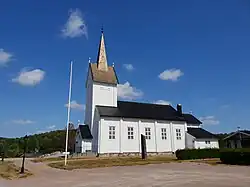 |
| Skjee | Skjee Church | Skjee | c. 1100 |  |
| Stokke | Stokke Church | Stokke | 1886 |  |
History

About 16,000 historic artifacts have been found at Brunstad in Stokke, mostly tools made out of flint but also roughly sixty hearths. The first recorded grave from Mesolithic times is also found here and dated to 5900 BCE.[16]
Leading up to 2017, Stokke residents were deciding whether or not to remain as an independent municipality or if they should merge with a neighboring municipality. Relatively few Stokke residents read Sandefjords Blad, the main newspaper of Sandefjord, and few residents reside or work in the city of Sandefjord. The wealthiness of Sandefjord, however, was often used as an argument for the merger with Sandefjord. Its international airport Sandefjord Airport, Torp was also seen as a deciding factor for Stokke's decision to merge into Sandefjord. For the village of Vear, on the other hand, a majority of residents preferred a merge into neighboring Tønsberg. Consequentially, the village was transferred into Tønsberg on 1 January 2017, the day Stokke joined Sandefjord.[9]: 72 Vear is home to 2,500 residents as of 2016, which made up 22 percent of Stokke's total population prior to the merge.[9]: 164–165
Sundås Fort

Remains of a fort, the Sundås battery, can be found across the Tønsbergfjorden from Håøya Island. The fortifications were constructed in the late 19th century during turbulent times with Sweden during the Union between Sweden and Norway. It was part of the newly established Norwegian Coastal Artillery (Norwegian: Kystartilleriet). The fort was erected to keep potential enemies from entering Tønsberg by sea, and was also meant to protect the Marine harbor in the village of Melsomvik. Work on the fort began in 1897, and the forts at both Håøya Island and Sundåsen were completed in 1899. Trenches, commando posts, fencing, concrete gun pits, and other remains from the fort can still be seen at Sundås. The fort lies by the Tønsbergfjord with surrounding views of Færder Lighthouse and islands such as Håøya, Tjøme, Veierland, and Nøtterøy. The cannons were demolished by German forces in 1942 during the German occupation of Norway. The Norwegian Armed Forces remained in control of the fort from 1945 until 1962, when it became public property.[17][18][19]
Government
While it existed, this municipality was responsible for primary education (through 10th grade), outpatient health services, senior citizen services, unemployment, social services, zoning, economic development, and municipal roads. During its existence, this municipality was governed by a municipal council of directly elected representatives. The mayor was indirectly elected by a vote of the municipal council.[20]
Municipal council
The municipal council (Kommunestyre) of Stokke was made up of representatives that were elected to four year terms. The tables below show the historical composition of the council by political party.
| Party name (in Norwegian) | Number of representatives | |
|---|---|---|
| Labour Party (Arbeiderpartiet) | 8 | |
| Progress Party (Fremskrittspartiet) | 2 | |
| Green Party (Miljøpartiet De Grønne) | 1 | |
| Conservative Party (Høyre) | 9 | |
| Christian Democratic Party (Kristelig Folkeparti) | 2 | |
| Centre Party (Senterpartiet) | 1 | |
| Socialist Left Party (Sosialistisk Venstreparti) | 1 | |
| Liberal Party (Venstre) | 1 | |
| Residents' List Stokke (Innbyggerlista Stokke) | 4 | |
| Total number of members: | 29 | |
| Note: On 1 Jan 2017, Stokke was dissolved and merged into Sandefjord Municipality | ||
| Party name (in Norwegian) | Number of representatives | |
|---|---|---|
| Labour Party (Arbeiderpartiet) | 11 | |
| Progress Party (Fremskrittspartiet) | 3 | |
| Conservative Party (Høyre) | 10 | |
| Christian Democratic Party (Kristelig Folkeparti) | 2 | |
| Centre Party (Senterpartiet) | 1 | |
| Socialist Left Party (Sosialistisk Venstreparti) | 1 | |
| Liberal Party (Venstre) | 1 | |
| Total number of members: | 29 | |
| Party name (in Norwegian) | Number of representatives | |
|---|---|---|
| Labour Party (Arbeiderpartiet) | 10 | |
| Progress Party (Fremskrittspartiet) | 6 | |
| Conservative Party (Høyre) | 6 | |
| Christian Democratic Party (Kristelig Folkeparti) | 3 | |
| Centre Party (Senterpartiet) | 2 | |
| Socialist Left Party (Sosialistisk Venstreparti) | 1 | |
| Liberal Party (Venstre) | 1 | |
| Total number of members: | 29 | |
| Party name (in Norwegian) | Number of representatives | |
|---|---|---|
| Labour Party (Arbeiderpartiet) | 9 | |
| Progress Party (Fremskrittspartiet) | 6 | |
| Conservative Party (Høyre) | 6 | |
| Christian Democratic Party (Kristelig Folkeparti) | 2 | |
| Centre Party (Senterpartiet) | 2 | |
| Socialist Left Party (Sosialistisk Venstreparti) | 3 | |
| Liberal Party (Venstre) | 1 | |
| Total number of members: | 29 | |
| Party name (in Norwegian) | Number of representatives | |
|---|---|---|
| Labour Party (Arbeiderpartiet) | 7 | |
| Progress Party (Fremskrittspartiet) | 3 | |
| Conservative Party (Høyre) | 13 | |
| Christian Democratic Party (Kristelig Folkeparti) | 4 | |
| Centre Party (Senterpartiet) | 3 | |
| Liberal Party (Venstre) | 1 | |
| Total number of members: | 31 | |
| Party name (in Norwegian) | Number of representatives | |
|---|---|---|
| Labour Party (Arbeiderpartiet) | 6 | |
| Progress Party (Fremskrittspartiet) | 3 | |
| Conservative Party (Høyre) | 11 | |
| Christian Democratic Party (Kristelig Folkeparti) | 3 | |
| Centre Party (Senterpartiet) | 5 | |
| Socialist Left Party (Sosialistisk Venstreparti) | 2 | |
| Liberal Party (Venstre) | 1 | |
| Total number of members: | 31 | |
| Party name (in Norwegian) | Number of representatives | |
|---|---|---|
| Labour Party (Arbeiderpartiet) | 6 | |
| Progress Party (Fremskrittspartiet) | 2 | |
| Conservative Party (Høyre) | 11 | |
| Christian Democratic Party (Kristelig Folkeparti) | 3 | |
| Centre Party (Senterpartiet) | 5 | |
| Socialist Left Party (Sosialistisk Venstreparti) | 3 | |
| Liberal Party (Venstre) | 1 | |
| Total number of members: | 31 | |
| Party name (in Norwegian) | Number of representatives | |
|---|---|---|
| Labour Party (Arbeiderpartiet) | 7 | |
| Progress Party (Fremskrittspartiet) | 4 | |
| Conservative Party (Høyre) | 11 | |
| Christian Democratic Party (Kristelig Folkeparti) | 3 | |
| Centre Party (Senterpartiet) | 3 | |
| Socialist Left Party (Sosialistisk Venstreparti) | 2 | |
| Liberal Party (Venstre) | 1 | |
| Total number of members: | 31 | |
| Party name (in Norwegian) | Number of representatives | |
|---|---|---|
| Labour Party (Arbeiderpartiet) | 9 | |
| Progress Party (Fremskrittspartiet) | 2 | |
| Conservative Party (Høyre) | 11 | |
| Christian Democratic Party (Kristelig Folkeparti) | 4 | |
| Centre Party (Senterpartiet) | 3 | |
| Socialist Left Party (Sosialistisk Venstreparti) | 1 | |
| Liberal Party (Venstre) | 1 | |
| Total number of members: | 31 | |
| Party name (in Norwegian) | Number of representatives | |
|---|---|---|
| Labour Party (Arbeiderpartiet) | 8 | |
| Progress Party (Fremskrittspartiet) | 1 | |
| Conservative Party (Høyre) | 12 | |
| Christian Democratic Party (Kristelig Folkeparti) | 4 | |
| Centre Party (Senterpartiet) | 3 | |
| Socialist Left Party (Sosialistisk Venstreparti) | 1 | |
| Liberal Party (Venstre) | 2 | |
| Total number of members: | 31 | |
| Party name (in Norwegian) | Number of representatives | |
|---|---|---|
| Labour Party (Arbeiderpartiet) | 8 | |
| Anders Lange's Party (Anders Langes parti) | 2 | |
| Conservative Party (Høyre) | 8 | |
| Christian Democratic Party (Kristelig Folkeparti) | 4 | |
| Centre Party (Senterpartiet) | 6 | |
| Socialist Left Party (Sosialistisk Venstreparti) | 1 | |
| Liberal Party (Venstre) | 2 | |
| Total number of members: | 31 | |
| Party name (in Norwegian) | Number of representatives | |
|---|---|---|
| Labour Party (Arbeiderpartiet) | 11 | |
| Conservative Party (Høyre) | 7 | |
| Christian Democratic Party (Kristelig Folkeparti) | 3 | |
| Centre Party (Senterpartiet) | 8 | |
| Liberal Party (Venstre) | 2 | |
| Total number of members: | 31 | |
| Party name (in Norwegian) | Number of representatives | |
|---|---|---|
| Labour Party (Arbeiderpartiet) | 9 | |
| Conservative Party (Høyre) | 7 | |
| Christian Democratic Party (Kristelig Folkeparti) | 1 | |
| Centre Party (Senterpartiet) | 6 | |
| Liberal Party (Venstre) | 2 | |
| Total number of members: | 25 | |
| Party name (in Norwegian) | Number of representatives | |
|---|---|---|
| Labour Party (Arbeiderpartiet) | 10 | |
| Conservative Party (Høyre) | 6 | |
| Christian Democratic Party (Kristelig Folkeparti) | 2 | |
| Centre Party (Senterpartiet) | 5 | |
| Liberal Party (Venstre) | 2 | |
| Total number of members: | 25 | |
| Party name (in Norwegian) | Number of representatives | |
|---|---|---|
| Labour Party (Arbeiderpartiet) | 9 | |
| Conservative Party (Høyre) | 7 | |
| Christian Democratic Party (Kristelig Folkeparti) | 2 | |
| Centre Party (Senterpartiet) | 5 | |
| Liberal Party (Venstre) | 2 | |
| Total number of members: | 25 | |
| Party name (in Norwegian) | Number of representatives | |
|---|---|---|
| Labour Party (Arbeiderpartiet) | 9 | |
| Conservative Party (Høyre) | 6 | |
| Christian Democratic Party (Kristelig Folkeparti) | 2 | |
| Farmers' Party (Bondepartiet) | 5 | |
| Liberal Party (Venstre) | 3 | |
| Total number of members: | 25 | |
| Party name (in Norwegian) | Number of representatives | |
|---|---|---|
| Labour Party (Arbeiderpartiet) | 8 | |
| Conservative Party (Høyre) | 6 | |
| Christian Democratic Party (Kristelig Folkeparti) | 2 | |
| Farmers' Party (Bondepartiet) | 5 | |
| Liberal Party (Venstre) | 3 | |
| Total number of members: | 24 | |
| Party name (in Norwegian) | Number of representatives | |
|---|---|---|
| Labour Party (Arbeiderpartiet) | 7 | |
| Christian Democratic Party (Kristelig Folkeparti) | 1 | |
| Joint List(s) of Non-Socialist Parties (Borgerlige Felleslister) | 16 | |
| Total number of members: | 24 | |
| Party name (in Norwegian) | Number of representatives | |
|---|---|---|
| Labour Party (Arbeiderpartiet) | 8 | |
| Conservative Party (Høyre) | 5 | |
| Farmers' Party (Bondepartiet) | 4 | |
| Joint list of the Liberal Party (Venstre) and the Radical People's Party (Radikale Folkepartiet) | 4 | |
| Joint List(s) of Non-Socialist Parties (Borgerlige Felleslister) | 3 | |
| Total number of members: | 24 | |
| Party name (in Norwegian) | Number of representatives | |
|---|---|---|
| Labour Party (Arbeiderpartiet) | 4 | |
| Conservative Party (Høyre) | 8 | |
| Farmers' Party (Bondepartiet) | 4 | |
| Liberal Party (Venstre) | 4 | |
| Joint List(s) of Non-Socialist Parties (Borgerlige Felleslister) | 4 | |
| Total number of members: | 24 | |
| Note: Due to the German occupation of Norway during World War II, no elections were held for new municipal councils until after the war ended in 1945. | ||
Mayors
The mayors (Norwegian: ordfører) of Stokke:[40][41]
- 1838–1841: Christian Richard Nygaard
- 1842–1843: Herman A. Klem
- 1843–1851: Ditman Ditmansen
- 1852–1853: Hans Mikkelsen
- 1854–1855: Ole Andersen
- 1856–1863: Ditman Ditmansen
- 1864–1865: Hans Christian Hansen
- 1866–1869: Johan Peder Andresen
- 1870–1886: Jørgen Hammelow Berg
- 1887–1897: Mathias L. Gjein (H)
- 1897–1898: Abraham Olsen (H)
- 1899–1901: Lars Sørensen Borge
- 1902–1904: Hans Mathias Korterød
- 1905–1910: Ragnvald Berg (V)
- 1911–1913: Ingvald Skorge (H)
- 1914–1919: Johan G. Austeen (V)
- 1920–1931: Ingvald Skorge (H)
- 1932–1941: Anders Ellefsen (H)
- 1941–1945: Lars Holt (NS)
- 1945–1946: Anders Ellefsen (H)
- 1946–1959: Olav O. Haugen (V)
- 1960–1963: Georg Aas (H)
- 1964–1971: Hans Wåle (Sp)
- 1972–1975: Oddvar Aas (H)
- 1976–1979: Tor Svensson (KrF)
- 1980–1987: Johnny Freitag (H)
- 1988–2003: Per-Eivind Johansen (H)
- 2003–2011: Nils Ingar Aabol (Ap)
- 2011–2016: Erlend Larsen (H)
Geography

Stokke municipality had a total area of 118 square kilometres (46 sq mi) and had a 14-kilometre (8.7 mi) long coastline along the Tønsbergfjord. The village of Stokke is located in-between the cities of Tønsberg and Sandefjord. However, Stokke was primarily a rural community and far smaller than its neighbors. Stokke had a variety of recreation areas, including the Storås area, which includes lakes, rivers, historic sites, and an abundance of plant and wildlife species. Another recreational site is located at Bogen, which also includes a beach and an art gallery. Other coastal communities include the villages of Vear, Melsomvik, and Storevar.[42] Islands included Langø, Ravnø, Gåsø, Gåsøkalven, Verjø, Tryteknatten, and others. Lakes include Akersvannet, Gjennestadvannet, Kulerødvannet, Fossnesdammen, and others. The former municipality was located south of Andebu, north of Sandefjord, west of the Tønsbergfjord, and southwest of Tønsberg and Ramnes.
Both the Vestfoldbanen railway line and the European route E18 highway pass through the former municipality. Its highest point was Høgståsen at 175.6 metres (576 ft). The village of Stokke is home to a nature preserve known as Bokemoa, a birch forest located on Raet.[43] The dense forest creates shade and a habitat for mushrooms; over 100 species of mushrooms have been recorded in Bokemoa, including species only found in birch tree forests.[44]: 84 [45][46]: 152

Nature preserves
Nature preserves in Stokke include the island of Langøya, Bokemoa, Melsomvik plant and wildlife preserve as well as the lakes Robergvannet and Akersvannet. The island of Langøya lies in the Tønsbergfjorden and is a car-free island consisting of meadows, knolls, salt meadows, small bays, and forests. It became a landscape conservation area in 2006. It is known for its wide variety of rare wildflowers including species such as sea thrift, alternate-leaved golden-saxifrage, cowslip, greater yellow-rattle, sticky catchfly, and many others.[46]: 148–151
Demographics
The annual population growth in Stokke was twice as high as Vestfold County as a whole, and the expected life expectancy is higher than the county median. About 13 percent of Stokke's population were first- or second-generation immigrants as of 2014.[9]: 79
Transportation
European route E18 passes through the former municipality. Vestfoldbanen operates the Stokke Station, a railway station in the village of Stokke. Sandefjord Airport Torp is located on the former border with Sandefjord municipality.
Recreation
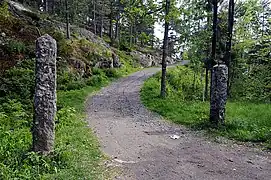
Hiking trails can be found at Trælsodden, Løke, Høgåsen, Grorudvannet, Feen, Furulund, Ramsum, and Borgeskogen. Coastal hiking paths make up a total of 14 kilometres (8.7 mi) in former municipality.[47]: 347 Coastal hiking trails can be found in Melsomvik and also a trail connecting Storevar and Rakkevik.
A 3-kilometre (1.9 mi) forest hike can be found at Løke, which is a popular forest for collecting mushrooms. A mountain trail is located by Høgåsen, the highest point in the former municipality with an elevation of 172 metres (564 ft). The peak can be reached from two trails: from Langevann in Re or from Grorudvannet in Stokke. The shortest hike is from Grorudvannet.[47]: 122–124, 243
Trælsodden by the Tønsbergfjorden is home to several burial mounds as well as fortifications dated to World War II. Sandy beaches, diving boards and hiking trails can also be found at Trælsodden.[48] At Trælsodden are graves dated to the Iron Age. At the time, sea levels were 4–5 metres (13–16 ft) higher than today, and the graves were consequentially placed near the shoreline. A popular fishing site is located between Trælsodden and Brunstad. The trail goes by the municipal beach at Brunstad, immediately south of Oslofjord Convention Center. During summers, convenience stores and seafood restaurants are open at Brunstad. From Brunstad, the coastal path heads inwards and passes through the Himalayapark, a park offering tree climbing. The trail passes by a home built by singer Jahn Teigen, known as "Teigen's Pyramid". The trail reaches a beach before entering the boat harbor in Rakkevik. It is a 3.5-kilometre (2.2 mi) hike from Storevar to Melsomvik, and a similar distance between Melsomvik and Brunstad.[47]: 358–362
Wildlife
Brown bears were common in Stokke until the 1850s, and until the early 1900s, a group of bears lived in the inner parts of Vestfold County. The last Brown bear shot in the county was in Lardal in 1916. The last bear to be shot in Stokke was around 1850 by Andreas Smitten of Russeltvet. A number of local place names derives from its former bears, including Bjønnemyra (Borgen), Bjønnestøkket (Bredholt), Bjønndal (Hauanlia), Bjønneleet (Nedre Anholt), and Bjønnelia (Askerød). Some place names also derive from the Gray wolf, including Ulvekula (Oserød) and Ulvehølet (Rørkollskogen). Other notable mammals in Stokke include the Red fox, European badger, European otter, European pine marten, Short-tailed weasel, European Lynx, Moose, Roe deer, Red deer, European beaver, Mountain hare, Red squirrel, European hedgehog, bats, mice, and rats.[49]
Points of interest
- Stokke Bygdetun, the oldest village museum in Vestfold County, established in 1978[44]: 84 [50]
- Sundås Fort, a fort from 1899 that was constructed during the Union between Sweden and Norway[44]: 43
- Trælsodden, a beach and remains from fortifications and burial mounds.
- Brunstad Beach
- Oslofjord Convention Center
- Stokke Station, a railway station operated by Vestfoldbanen
- Bokemoa, a birch tree forest and nature preserve on Raet
- Bogen, a beach and hiking trails
- Storevar, a small coastal village
- Stokke Church, a brick church by architect Jacob Wilhelm Nordan from 1886[51]
Notable people
- Einar Tørnquist, a TV-personality, talk-show host, and podcaster
- Lise Davidsen, an opera singer
See also
References
- ↑ "Navn på steder og personer: Innbyggjarnamn" (in Norwegian). Språkrådet.
- ↑ "Forskrift om målvedtak i kommunar og fylkeskommunar" (in Norwegian). Lovdata.no.
- ↑ "Forskrift om målvedtak i kommunar og fylkeskommunar" (in Norwegian). Lovdata.no. 5 May 2006.
- ↑ Bolstad, Erik; Thorsnæs, Geir, eds. (26 January 2023). "Kommunenummer". Store norske leksikon (in Norwegian). Kunnskapsforlaget.
- ↑ Statistisk sentralbyrå. "Table: 06913: Population 1 January and population changes during the calendar year (M)" (in Norwegian).
- ↑ Statistisk sentralbyrå. "09280: Area of land and fresh water (km²) (M)" (in Norwegian).
- ↑ Ormestad, Stian (31 December 2016). "Her går en god nabo gjennom 179 år over i historien". Reavisa.no. Retrieved 10 December 2018.
- ↑ Jukvam, Dag (1999). "Historisk oversikt over endringer i kommune- og fylkesinndelingen" (PDF) (in Norwegian). Statistisk sentralbyrå. ISBN 9788253746845.
- 1 2 3 4 5 6 Larsen, Erlend (2016). Tre kommuner blir til én: Suksesskriteriene bak nye Sandefjord (in Norwegian). E-forl. ISBN 9788293057277.
- ↑ "Vedtak om sammenslåing av Stokke, Andebu og Sandefjord kommuner, Vestfold". Lovdata.no (in Norwegian). Norges kommunal- og arbeidsdepartementet. 24 April 2015. Retrieved 17 November 2023.
- ↑ Indreiten, Aina Beate (18 December 2015). "Vear skal til Tønsberg". Nrk.no. Retrieved 10 December 2018.
- ↑ Rygh, Oluf (1907). Norske gaardnavne: Jarlsberg og Larviks amt (in Norwegian) (6 ed.). Kristiania, Norge: W. C. Fabritius & sønners bogtrikkeri. pp. 27 and 179.
- ↑ "Civic heraldry of Norway - Norske Kommunevåpen". Heraldry of the World. Retrieved 17 November 2023.
- ↑ "Stokke, Vestfold (Norway)". Flags of the World. Retrieved 17 November 2023.
- ↑ "Godkjenning av våpen og flagg". Lovdata.no (in Norwegian). Norges kommunal- og arbeidsdepartementet. 15 March 1984. Retrieved 17 November 2023.
- ↑ Reitan, Gaute; Danielsen, Fredrikke; Gummesen, Sara; Schülke, Almut (2019). "Brunstad i Stokke, Vestfold – et bosettingsområde fra rundt 6000 f.Kr., med spor etter gjentatte besøk, grav og deponeringer". Viking. 82: 33. doi:10.5617/viking.7115. hdl:10852/74691. Retrieved 2 November 2020.
- ↑ "Sundås". Forsvarsbygg.no. Retrieved 10 December 2018.
- ↑ "Sundåsen batteri". Kystfort.info. Retrieved 10 December 2018.
- ↑ "Sundåsen fort Stokke". Oslofjorden.com. Retrieved 10 December 2018.
- ↑ Hansen, Tore; Vabo, Signy Irene, eds. (20 September 2022). "kommunestyre". Store norske leksikon (in Norwegian). Kunnskapsforlaget. Retrieved 3 August 2023.
- ↑ "Kommunestyrevalg 2015 - Telemark". Valg Direktoratet.
- 1 2 3 4 "Table: 04813: Members of the local councils, by party/electoral list at the Municipal Council election (M)" (in Norwegian). Statistics Norway.
- ↑ "Kommunestyrevalg 2011 - Telemark". Valg Direktoratet.
- ↑ "Kommunestyrevalget 1999" (PDF) (in Norwegian). Oslo-Kongsvinger, Norge: Statistisk sentralbyrå. 2000. ISBN 8253748531. ISSN 0332-8023.
- ↑ "Kommunestyrevalget 1995" (PDF) (in Norwegian). Oslo-Kongsvinger, Norge: Statistisk sentralbyrå. 1996. ISBN 8253743351. ISSN 0332-8023.
- ↑ "Kommunestyrevalget 1991" (PDF) (in Norwegian). Oslo-Kongsvinger, Norge: Statistisk sentralbyrå. 1993. ISBN 8253737939. ISSN 0332-8023.
- ↑ "Kommunestyrevalget 1987" (PDF) (in Norwegian). Oslo-Kongsvinger, Norge: Statistisk sentralbyrå. 1988. ISBN 8253726325. ISSN 0332-8023.
- ↑ "Kommunestyrevalget 1983" (PDF) (in Norwegian). Oslo-Kongsvinger, Norge: Statistisk sentralbyrå. 1984. ISBN 8253720378. ISSN 0332-8023.
- ↑ "Kommunestyrevalget 1979" (PDF) (in Norwegian). Oslo, Norge: Statistisk sentralbyrå. 1979. ISBN 8253710836. ISSN 0332-8023.
- ↑ "Kommunevalgene 1975" (PDF) (in Norwegian). Oslo, Norge: Statistisk sentralbyrå. 1977. ISBN 8253705646.
- ↑ "Kommunevalgene 1972" (PDF) (in Norwegian). Oslo, Norge: Statistisk sentralbyrå. 1973. ISBN 8253701144.
- ↑ "Kommunevalgene 1967" (PDF) (in Norwegian). Oslo, Norge: Statistisk sentralbyrå. 1967.
- ↑ "Kommunevalgene 1963" (PDF) (in Norwegian). Oslo, Norge: Statistisk sentralbyrå. 1964.
- ↑ "Kommunevalgene og Ordførervalgene 1959" (PDF) (in Norwegian). Oslo, Norge: Statistisk sentralbyrå. 1960.
- ↑ "Kommunevalgene og Ordførervalgene 1955" (PDF) (in Norwegian). Oslo, Norge: Statistisk sentralbyrå. 1957.
- ↑ "Kommunevalgene og Ordførervalgene 1951" (PDF) (in Norwegian). Oslo: Statistisk sentralbyrå. 1952.
- ↑ "Kommunevalgene og Ordførervalgene 1947" (PDF) (in Norwegian). Oslo: Statistisk sentralbyrå. 1948.
- ↑ "Kommunevalgene og Ordførervalgene 1945" (PDF) (in Norwegian). Oslo: Statistisk sentralbyrå. 1947.
- ↑ "Kommunevalgene og Ordførervalgene 1937" (PDF) (in Norwegian). Oslo: Statistisk sentralbyrå. 1938.
- ↑ Berg, Lorens (1928). Stokke : en bygdebok : historisk skildring av bygdens utvikling fra gammel tid ned til kjendte nutidsforhold (in Norwegian). Oslo: Stokke kommune.
- ↑ Christensen, Nils Steen; Hagelund, Olav (1983). Stokke Bygdebok (in Norwegian). Vol. 2. Stokke kommune. pp. 208–210.
- ↑ Bertelsen, Hans Kristian (1998). Bli kjent med Vestfold [Become acquainted with Vestfold]. Stavanger Offset AS. pp. 114–115. ISBN 9788290636017.
- ↑ "Naturbase faktaark". Faktaark.naturbase.no. Retrieved 10 December 2018.
- 1 2 3 Gjerseth, Simen (2016). Nye Sandefjord (in Norwegian). Liv forlag. ISBN 9788283301137.
- ↑ "Bokkemoa" (PDF). Fylker.miljostatus.no. Retrieved 10 December 2018.
- 1 2 Schandy, Tom; Helgesen, Tom (2012). Naturperler i Vestfold (in Norwegian). Forlaget Tom & Tom v/Schandy. ISBN 9788292916148.
- 1 2 3 Larsen, Erlend (2011). På Tur i Vestfold del 2 (in Norwegian). E-forlag. ISBN 9788293057222.
- ↑ "Disse 10 fotturene er de beste i Vestfold". Sandefjords Blad (in Norwegian). 21 September 2015. Retrieved 10 December 2018.
- ↑ Christensen, Nils Steen (1979). Stokke bygdebok 1 (in Norwegian). Stokke kommune. pp. 303–310. Retrieved 12 August 2021.
- ↑ "Stokke Bygdetun". VisitVestfold.com. Retrieved 10 December 2018.
- ↑ "Stokke Church". VisitVestfold.com. Retrieved 10 December 2018.
External links
 Media related to Stokke at Wikimedia Commons
Media related to Stokke at Wikimedia Commons The dictionary definition of Stokke at Wiktionary
The dictionary definition of Stokke at Wiktionary Vestfold travel guide from Wikivoyage
Vestfold travel guide from Wikivoyage Stokke travel guide from Wikivoyage
Stokke travel guide from Wikivoyage


